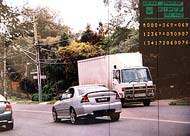Article from: www.thenewspaper.com/news/19/1937.asp
8/27/2007
Australian Motorists Prove the Speed Camera Lied
Two Melbourne, Australia motorists proved that speed cameras falsely accused them of speeding.
 Most drivers do not have the patience or desire to risk fines and court costs of up to A$5000 for daring to challenge a speed camera ticket in Victoria, Australia. Instead, they pay the fine -- even when they know they had done nothing wrong. Now that Melbourne motorists Claus Salger and John King have beaten the devices in court, however, others are interested in copying their technique.
Most drivers do not have the patience or desire to risk fines and court costs of up to A$5000 for daring to challenge a speed camera ticket in Victoria, Australia. Instead, they pay the fine -- even when they know they had done nothing wrong. Now that Melbourne motorists Claus Salger and John King have beaten the devices in court, however, others are interested in copying their technique.
In a case that ended last year, a speed camera accused Salger of driving his Nissan Patrol SUV at 59 km/h (37 MPH) in a 50 km/h (31 MPH) zone and demanded that he pay A$160 for the offense. Salger, an electronics expert, knew the speed reading was incorrect, but under Victoria state law, drivers are considered automatically guilty as long as the speed camera operator shows that he properly set up a calibrated camera.
Salger fought back by using the freedom of information law to gain access to the speed camera's official documentation. A court order only allowed him briefly to examine, not keep, a copy of the information. A formula in a document called the "verifications manual" explained how he could double-check the speed claimed in the photograph.
"I had to have accelerated at 15,000 km/h (9320 MPH) for my vehicle to be in the position it was photographed," Salger told the Herald Sun newspaper.
Broadmeadows Magistrates' Court found Salger not guilty. When Salger agreed to be the expert witness for another motorist, John King, the pair fought a losing 18-month battle to obtain the verifications manual a second time. Victoria Police now said the verifications manual no longer exists and the department will not release it under freedom of information laws. Instead, Salger and King used the manual carried by the Tenix employees who drive speed camera cars and set up the automated ticketing machine. The manual gives examples of proper positioning of the device, and improper positioning. Two vertical lines overlaid onto the photo, 61 percent from the left of the image and 82 percent from the left, will show the beam width (see photo). If the photographed vehicle is not within the lines, the system was not properly set up, according to the manual. The speed measured could be that of another object within the radar beam.
Hearing this evidence in March, Heidelberg Magistrates' Court found King not guilty and ordered the state to pay him A$1260 in legal fees. King and Hardy will now testify as expert witnesses in a case for a third motorist scheduled to be heard in November.
Source: More rush to challenge speed camera fines (Herald Sun (Australia), 8/27/2007)
Permanent Link for this item
Return to Front Page
 Most drivers do not have the patience or desire to risk fines and court costs of up to A$5000 for daring to challenge a speed camera ticket in Victoria, Australia. Instead, they pay the fine -- even when they know they had done nothing wrong. Now that Melbourne motorists Claus Salger and John King have beaten the devices in court, however, others are interested in copying their technique.
Most drivers do not have the patience or desire to risk fines and court costs of up to A$5000 for daring to challenge a speed camera ticket in Victoria, Australia. Instead, they pay the fine -- even when they know they had done nothing wrong. Now that Melbourne motorists Claus Salger and John King have beaten the devices in court, however, others are interested in copying their technique.